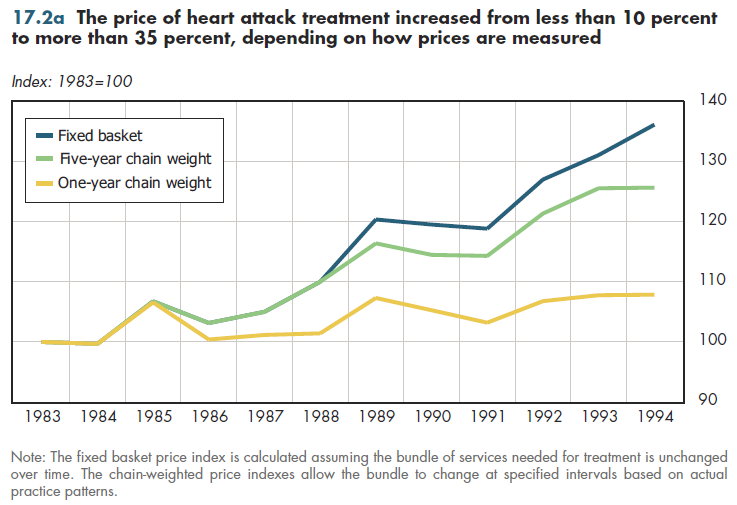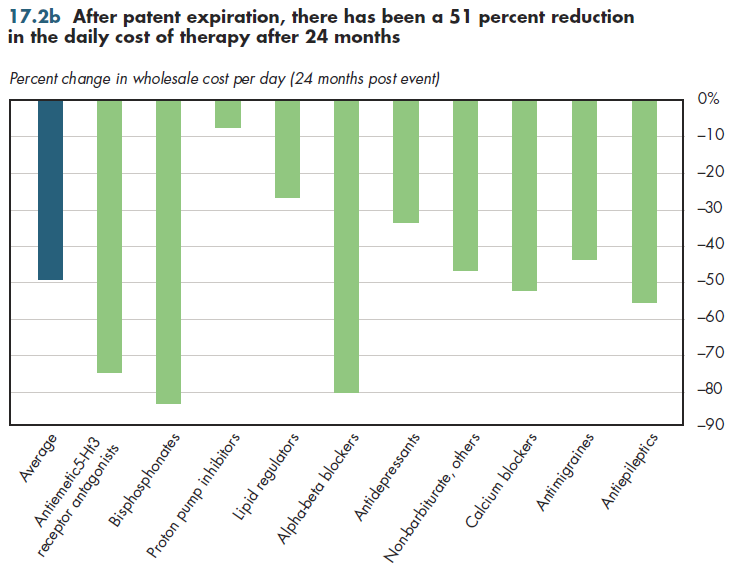Download PowerPoint versions of both figures.
Inside Collection (Book): American Health Economy Illustrated
17.2 How Price of Treatments Changes over Time Depends on How Innovations Are Measured
Summary: In price measurement, the treatment of innovations or new products is perhaps the most difficult aspect of handling quality change.
For decades, medical prices have outstripped general inflation. Price trends vary by medical service, with prices for some services rising much faster than for others. When the BLS measures prices for other commodities, it is straightforward to measure how the price of a discrete item, such as an apple, changes over time.
This task is much more difficult in health care. The price of a hospital room, for example, does not include the much larger costs of actually occupying a bed. Moreover, even if the price could be precisely calculated, a hospital stay today is a dramatically different product than it was 50 or even 30 years ago. Unless the BLS can account for changes in technology and quality of care, the measured price of hospital care will give an exaggerated picture of how "pure" prices are rising over time.
Even if that task could be performed perfectly, such prices do not represent what is important: How much is the cost of treatment increasing? Even if we knew all the services needed for treatment, the answer depends on whether we assume that bundle of services is fixed over time or can be adjusted to account for actual changes in medical practice (figure 17.2a). Prescription drugs are another good example. Increases in the price of a particular drug are reasonably straightforward to measure. However, the average cost of the "blue pill" is not a good indicator of how much more patients have to pay for treatment for two major reasons. First, if a drug goes off-patent, generic competitors will appear with lower prices. Even for brand names for which there is not yet a generic substitute, there can be competitor drugs similar enough in function whose prices might be rising much more slowly. This could result in many patients switching to those alternatives if prices of the blue pill got too high.

When the price of treatment is taken into account, for example, the cost per day to treat depression or high cholesterol, rising drug prices (that is, the price of blue pills) can easily co-exist with falling costs for treatment (figure 17.2b). For social welfare, knowing how the price of various medical treatments is changing is a far better indicator than knowing how the price of individual components of a given treatment is changing. In a highly innovative medical system, new competing treatments appear all the time as do changes in the mix of resources required for a given treatment. Systematic price measurement of treatments is in its infancy.

Downloads
References
- Berndt ER and M Aitken. A Different Perspective: The AARP Sponsored Schon- delmeyer-Purvis Studies. In Scaring Seniors: The AARP Drug-Price Reports. American Enterprise Institute. Washington DC. 2010.
- Cutler DM, M McClellan, JP Newhouse and D Remler. Pricing Heart Attack Treatments. Medical Care Output and Productivity. National Bureau of Economic Research. http://www.nber.org/chapters/c7634.pdf (accessed August 9, 2010).
Collection Navigation
- « Previous module in collection 17.1 Average American's Stock of Health Is Several Multiples of Lifetime Earnings
- Collection home: American Health Economy Illustrated
- Next module in collection » 17.3 Technology Has Been An Important Driver of Health Spending
Content actions
Give feedback:
Download:
Add:
Reuse / Edit:
Twin Cities Campus:
- © 2012 Regents of the University of Minnesota. All rights reserved.
- The University of Minnesota is an equal opportunity educator and employer. Privacy
- Last modified on Sep 24, 2013 4:15 pm -0500









